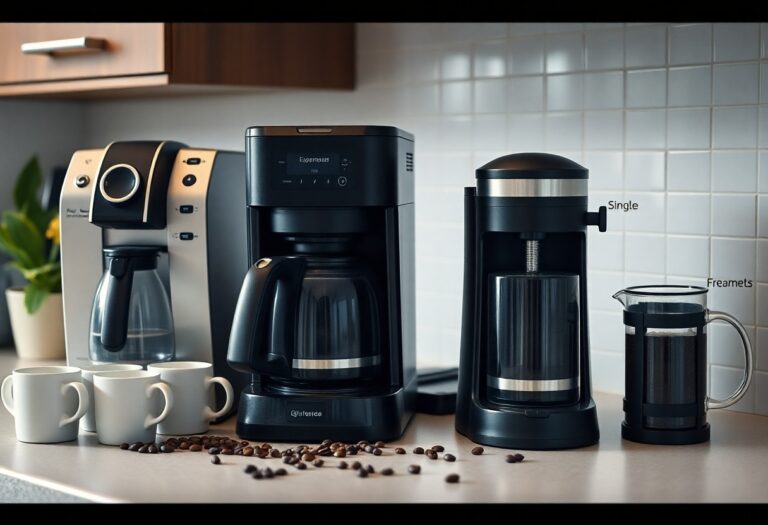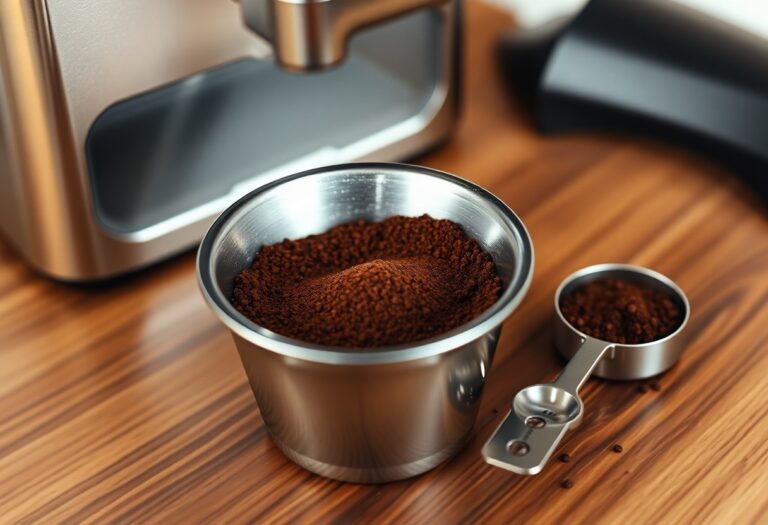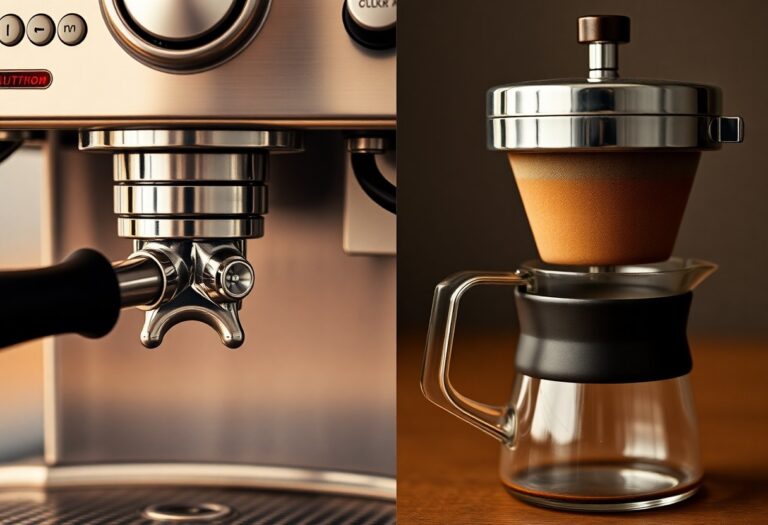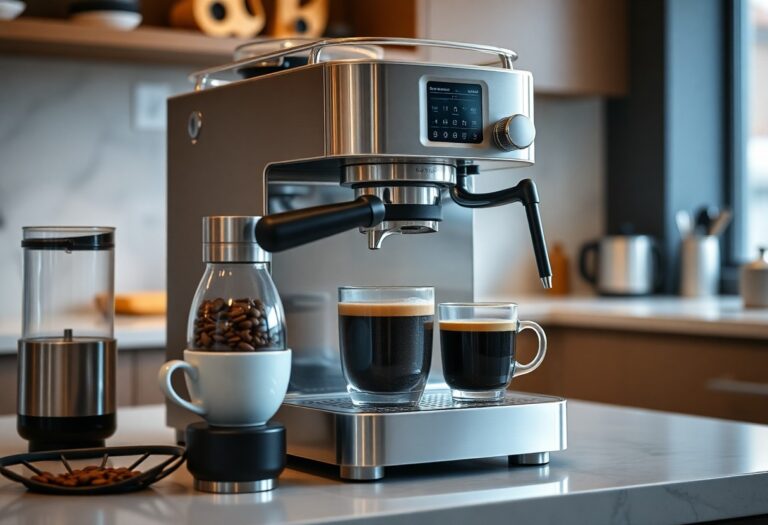What Does Bar Pressure Mean on a Coffee Machine – Technical Specs
Most coffee enthusiasts may overlook the significance of bar pressure in a coffee machine, yet it is integral to crafting your perfect cup. Understanding the ideal pressure levels can elevate your brewing technique and result in rich, flavorful espresso. A machine operating at around 9 bars typically extracts the best flavors without over-extraction, leading to a balanced taste. On the other hand, too high or too low pressure can ruin your brew, affecting everything from aroma to crema. Dive deeper to ensure you’re making the best coffee you can!

Key Takeaways:
- Bar pressure indicates the amount of pressure exerted by the coffee machine during the brewing process, typically measured in bars.
- Most espresso machines operate between 8 to 12 bars of pressure, which is vital for extracting the best flavors and oils from coffee grounds.
- Higher pressure does not always equate to better coffee; it can lead to over-extraction, resulting in bitter flavors.
- Bar pressure can vary based on the coffee type, grind size, and brewing method, highlighting the importance of finding the right balance.
- Monitoring bar pressure can help users troubleshoot extraction issues, ensuring consistent coffee quality from their machine.
The Science of Bar Pressure: How It Affects Extraction
Bar pressure plays a vital role in the extraction process of coffee, influencing the flavors, aromas, and overall quality of your brew. The right amount of pressure allows water to permeate the coffee grounds evenly, ensuring that soluble compounds are properly extracted. If the pressure is too low, you’ll end up with under-extracted coffee, resulting in sour or acidic flavors. Conversely, excessive pressure can lead to over-extraction, causing bitterness. Striking a balance in bar pressure is vital for achieving the perfect cup of coffee.
The Role of Pressure in Brewing Coffee
In brewing, pressure activates the coffee’s oils and solubles, enhancing the extraction of flavors and aromas. As hot water passes through the coffee bed, the pressure forces the water to encounter the fine particles, allowing soluble materials to dissolve effectively. This dynamic interaction can bring out rich, complex flavors that are otherwise missed at lower pressures.
Understanding the Ideal Bar Pressure Range
The ideal bar pressure for brewing espresso typically falls between 8 and 10 bars, with many machines calibrated to around 9 bars. This range is vital for optimal extraction, ensuring that you achieve a full-bodied flavor profile without compromising taste. Adjustments in grind size and coffee dosage can help maintain pressure consistency, allowing for customization based on your personal preferences.
Staying within the ideal bar pressure range is not just about consistency; it directly influences the extraction time and the end flavor of your coffee. Under ideal circumstances, the water should flow through your coffee grounds in about 25 to 30 seconds at 9 bars, producing a crema that signifies quality. Variations outside this range can lead to undesirable taste profiles, affecting the body, acidity, and overall enjoyment of your brew. Therefore, knowing how to monitor and adjust bar pressure is key to crafting that perfect cup.
Decoding Your Coffee Machine’s Pressure Gauge
Your coffee machine’s pressure gauge provides valuable insights into the brewing process. Understanding these readings enables you to fine-tune your brew for optimal flavor. For more on how varying pump pressures affect your coffee, check out this discussion on what is a pump pressure bar? From 19 to 15 makes a huge …. These gauge readings can significantly influence your coffee’s taste, smoothness, and extraction quality.
Types of Pressure Gauges Found on Coffee Machines
Various pressure gauges can be utilized on your coffee machine, giving you insights into its performance levels. The most common types include:
- Analog Gauges: Display readings via a dial.
- Digital Gauges: Offer precise readings on a digital screen.
- Built-in Displays: Integrated into the machine for real-time monitoring.
- External Attachments: Standalone gauges that connect to the brew head.
- PID Controllers: Control temperature and pressure for precision brewing.
Thou can take advantage of these gauges to ensure you maintain consistent pressure levels during every brew cycle.
| Type of Gauge | Description |
|---|---|
| Analog Gauges | Use mechanical dials to indicate pressure. |
| Digital Gauges | Provide numeric pressure data on a screen. |
| Built-in Displays | Combined with machines for convenience. |
| External Attachments | Separate gadgets for monitoring pressure. |
| PID Controllers | Advance adjustment for pressure and temperature. |
Interpreting Readings: What They Mean for Your Brew
Reading your coffee machine’s pressure gauge offers insight into brewing performance. A typical range for most espresso machines hovers around 9 to 10 bars. If your machine shows a lower pressure, you may experience under-extraction—resulting in a sour taste and weak body. Conversely, exceeding the 10-bar threshold can lead to over-extraction, creating bitterness and an undesirable flavor profile. By calibrating your machine’s pressure, you can significantly improve the quality of your cup.
When you interpret your pressure readings, remember they act as a guide to achieving the perfect espresso. The ideal extraction happens at around 9 bars, ensuring adequate flavor extraction without bitterness. If the pressure dips below this point, you’re likely missing out on the rich, creamy mouthfeel that good coffee provides. Monitoring your gauge can lead you to customize your brewing process, allowing you to deliver exceptional coffee consistently.
The Coffee Extraction Equation: Pressure, Time, and Flavor
The relationship between pressure, brew time, and flavor is at the heart of a great coffee extraction. Your coffee’s taste profile is largely determined by how well you can balance these three variables. A stable pressure range of around 9 bars typically ensures optimal extraction, allowing soluble compounds to be drawn from the coffee grounds effectively, resulting in that rich bouquet of flavors you crave. Lower or higher pressure levels can lead to under-extraction, where sour notes dominate, or over-extraction, creating a bitter brew.
The Relationship Between Pressure and Brew Time
Pressure and brew time are intimately linked; increasing pressure usually shortens the brew time required to extract flavors effectively. For instance, with a standard espresso shot, maintaining around 9 bars for about 25-30 seconds yields a balanced shot with complex flavors. Deviating from that standard pressure can either extend or shorten the necessary brew time, thus altering the final flavor of your coffee.
How Pressure Influences Taste Profiles
Your coffee’s profile can change dramatically based on the pressure at which it’s brewed. The *solubility rates* of different compounds—like acids, sugars, and oils—vary with pressure, affecting the final flavor. At high pressure, you extract a richer body, enhanced sweetness, and creamy mouthfeel; conversely, low pressure tends to bring out brighter acidity but often at the expense of depth.
For example, brewing at 6 bars may intensify citrus notes and reduce syrupy textures, leading to a lighter cup. In contrast, operating closer to 10 bars might amplify dark chocolate and caramel flavors, lending a fuller body and richness. This interplay demonstrates how mastering pressure in your brewing process allows you to unlock an extensive range of tastes, creating personalized coffee experiences tailored to your palate. Balancing these elements can transform an ordinary brew into a memorable sensory experience.
Troubleshooting Bar Pressure Issues in Coffee Machines
Experiencing problems with bar pressure can significantly affect your coffee-making experience, leading to disappointment in flavor and extraction. Several factors can contribute to pressure issues, making it crucial to identify and rectify them for optimal performance. Regular maintenance and understanding potential problems will ensure your coffee machine continues to deliver the quality espresso you crave.
Common Bar Pressure Problems Faced by Users
Many users face bar pressure inconsistencies, with symptoms like weak extraction, overly bitter coffee, or even machine shutdowns. Inadequate water supply due to blockages, worn-out seals, or miscalibrated pressure settings often leads to these issues. Observing the pressure gauge during operation will help diagnose these problems, as fluctuations or readings outside the normal 9-10 bar range indicate deeper issues.
Steps to Diagnose and Adjust Your Machine’s Pressure
To diagnose and adjust your machine’s pressure, start by checking for clogs in the portafilter and group head. Next, inspect the water tank for blockages, ensuring it delivers a steady flow. If pressure remains inconsistent, recalibrating the machine’s pressure settings may be necessary. Use manufacturer guidelines for specific calibration techniques and make adjustments accordingly to achieve the ideal espresso brewing pressure.
Diving deeper into the adjustment process involves pinpointing the source of pressure issues. Once you’ve inspected the portafilter and group head, and ensured a clear water supply, assess the pump’s performance. Some machines allow you to modify the pump’s output pressure directly; refer to your manual for precise instructions. Keeping track of changes and comparing the taste quality of your brews can help you fine-tune the ideal bar pressure for your perfect cup of coffee.

Expert Opinions: Bar Pressure Insights from Professional Baristas
You’ll find that established baristas often emphasize the importance of consistent bar pressure in achieving a well-balanced espresso. Many endorse the sweet spot of 9 bars, asserting that this level optimally extracts the crucial oils and flavors from the coffee grounds. They argue that deviations can lead to either over-extraction, yielding a bitter taste, or under-extraction, producing a sour brew. For more details, you can read more on What is the ‘bar’ pressure of a commercial espresso…
What Baristas Look for in Pressure Settings
Baristas keenly observe not just the numerical pressure setting on the machine, but also the flow rate of the espresso extraction. A well-calibrated machine should yield a shot within 25 to 30 seconds, with a rich crema layer. Variations in pressure setting directly influence this timing, allowing you to experiment and refine your technique to achieve that perfect shot.
Narratives of Pressure Mistakes and Their Impact on Coffee Quality
You might be surprised at how a simple pressure mistake can dramatically alter the final cup of coffee. Many baristas recount early experiences where inconsistent pressure settings led to either a flat brew or a harsh, bitter aftertaste. One barista shared a scenario where adjusting the pressure from 7 to 10 bars resulted in a significant flavor improvement, turning a lackluster espresso into a vibrant, complex drink with a delightful afternote. Such stories underline the crucial role of bar pressure in achieving coffee excellence.
Summing up
Now you understand that bar pressure on a coffee machine is key to extracting the perfect espresso. By paying attention to the bar pressure specifications, you can enhance your brewing technique and tailor the flavor profile to your preference. A standard pressure of 9 bars is often recommended, but experimenting with variations can lead to delicious discoveries. Ultimately, your mastery of bar pressure will elevate your coffee-making skills and ensure that each cup you brew meets your personal taste standards.
FAQ
Q: What does bar pressure mean on a coffee machine?
A: Bar pressure on a coffee machine refers to the measure of pressure used during the espresso brewing process. It indicates how much pressure is exerted by the coffee machine’s pump to force hot water through the coffee grounds. A standard espresso typically requires around 9 bars of pressure to achieve the optimal extraction of flavors and oils from the coffee.
Q: Why is bar pressure important for brewing espresso?
A: Bar pressure is crucial because it directly affects the extraction process of coffee. If the pressure is too low, the espresso can be weak and under-extracted, resulting in a sour taste. Conversely, too high a pressure can cause over-extraction, making the espresso bitter. Achieving the right pressure is vital for a balanced and flavorful shot of espresso.
Q: How can I adjust bar pressure on my coffee machine?
A: The ability to adjust bar pressure on a coffee machine depends on the model. Some commercial and high-end home machines allow for pressure adjustments through settings on the machine or through modifications to the pump or brewing system. Review your machine’s user manual for specific instructions, and consult with a professional if you’re unsure about making adjustments.
Q: Is higher bar pressure always better for making coffee?
A: Not necessarily. While higher bar pressure can lead to a richer extraction under certain conditions, it does not mean it is always the best choice. Generally, an optimal brewing pressure is around 9 bars. Using a pressure significantly higher than this can lead to over-extraction and undesirable flavors. It’s about finding the right balance for the type of coffee beans and the desired taste.
Q: How do I know if my coffee machine is producing the correct bar pressure?
A: Most espresso machines come equipped with a pressure gauge that displays the bar pressure during extraction. To check if your machine is producing the correct pressure, observe the gauge while brewing. For a well-extracted espresso, you should see the needle stabilize around 9 bars during extraction. If you notice consistently lower or higher pressures, regular maintenance or adjustment may be necessary.







